 |
a booklet issued by
the manufacturers, called Tuning for M.G. Midget Engines.
Now, it must be pointed out that although the manufacturers are in a-position
to say what should be done, and also to supply the special components required
for some of the stages, they are not able to supply new cars in a tuned form or
to tune owners' cars, as this would, of course, interfere with normal
production. However, if it is known what to do and what not to do there is a
good chance of success. More important even than this, perhaps, is a clear idea
of what the ultimate result is likely to be when the tuning is finished.
Consequently, The Autocar has, over a period of several months, exhaustively
road tested a TD M.G. in its various tuning stages from standard production to
Stage 5.
Before any tuning is attempted it must be decided for what purpose the car is
required; also-and this will to a certain extent be inter-related with the
first consideration- what type of fuel is available to run it on. The fuel
question is of vital importance, and until this has been decided very little
tuning of any kind can be done. Each type and blend of fuel has what is known
as a highest useful compression ratio; therefore, unless the octane rating of
the fuel will permit, there is no point in increasing the compression ratio,
which is one of the best-known methods of increasing performance. Another
method of increasing engine output is by supercharging, which may also in some
cases be accompanied by an increase in compression ratio. Apart from the
fundamental changes of the type mentioned, there are two other ways of
improving engine performance. One is to reduce the friction between the moving
parts, and the other is to improve the volumetric efficiency or breathing.
These two items are not brought about by any form of magic, but by hard work
and skillful use of tools, much patience, a basic knowledge of what can be done
and cannot be done, and still more hard work.
Making the Most of the Power
A stage-by-stage treatment-of the engine will be given later, but before this
is done there are other aspects of the tuning that must be considered. Briefly,
the performance of a car depends on the power required relative to the power
that is available. Now, assuming that the total weight is not affected much
during the tuning, and also that the body shape remains unchanged, the curve
showing the power required to drive the car will remain the same.
To determine the required overall gear ratio it is necessary to have a
knowledge of both the power required and the power available if the best
overall performance is to be obtained. If the gear ratio has been determined
for a car powered by an engine that develops, say, 54 b.h.p., as in the
standard TD M.G., it is obvious that if the power out- put is increased to any
marked degree some modification to the overall gear ratio will be required. If
this is not done the engine will have exceeded its maximum safe working speed
in r.p.m. before the maximum speed is reached corresponding to the power
available. This means that for a given car, if the b.h.p. is increased I the
m.p.h. per 1,000 r.p.m. of the engine on top gear must also be increased, and
to do "this the gear ratio must be lowered [Thus providing a higher
gear.-ED.] or a similar effect produced, for example, by fitting larger
diameter tyres to the rear wheels. Modifications made to the axle ratio on the
M.G. are listed in Table 1, and a graph shows the effect on the performance
|
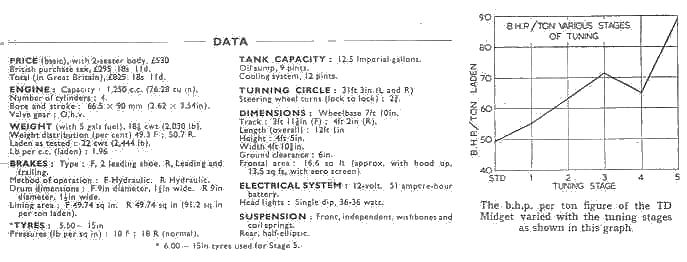
in the indirect
ratios produced by these changes. The effect of weight is important in tuning,
but it should be remembered that it is the total drag that affects the maximum
speed, 'and the weight that affects acceleration. However, if the weight is not
kept to a minimum the resultant loss of potential acceleration may mean that
the car must slow down for a comer or because of other traffic, before its
maximum speed is ever reached; also, the lighter the car the less work there is
for the brakes.
The car used for these tests was first submitted in standard trim. It was put
through its paces, and, in fact, given the normal Road Test routine, including
several hundred miles of normal road running to enable the driver to get to
know the car as regards both performance and feel. In standard trim the Midget
is a very satisfactory car. On looking back, after having driven it when its
maximum speed was around the 100 mark, it would perhaps be thought slow by
those interested only in sheer performance. Yet the ultimate maximum speed is
not the only consideration, and in standard form the car recorded a mean
maximum speed of 72.5 m.p.h., and this from an engine of only 1-41-litre
capacity. On Pool fuel the engine is very smooth and flexible, so that the car
is quite suitable for use when frequent stops and slowing down are demanded, as
well as for fast open-road cruising.
Stage One
Perhaps the most noticeable increase in performance, yet one that keeps the car
still very much an everyday vehicle as opposed to one that is used for special
purposes, is the initial tuning modifications from standard to Stage 1. This is
a simple tune-up and consists of raising the compression ratio to 8.6 by I (by
means of machining -3/32 in off the cylinder head face), polishing out the
ports, fitting larger valves and |
consequently stronger
valve springs, and replacing the 1.25in diameter twin S.U. carburetors with
1.5in diameter components, fed by the twin fuel pumps. Modifications to the
chassis consisted of lowering the axle ratio from 5.125 to 4.875, to I and
fitting an extra set of dampers. Also, purely for the personal comfort of the
driver, who was not in favour of driving with the windscreen flat with air
temperatures around freezing point, a glass plate type of defroster unit was
fitted to the windscreen.
The first impression on driving the car in Stage I form was the very
considerable increase in liveliness that it has, and under test conditions this
impression was confirmed. The maximum speed was increased by 5 m.p.h. and there
was also a marked improvement in the acceleration figures through the gears.
Acceleration times in one gear from constant speeds, however, were, generally
speaking, longer. Now this fact is interesting as it shows one of the
fundamental things about tuning that is sometimes overlooked; that is, as the
top end performance is increased, the bottom end power and consequently some of
the flexibility also are often lost. For example, if the valve throat diameter
is increased to improve the breathing at the top end the gas speed at low
engine speeds will he reduced. This means that the pulling power and
flexibility at low speeds on top gear will perhaps not be very good, and in
consequence more use of the indirect gears must be made. In turn this may
result in an increased fuel consumption. This trend can be seen throughout the
whole of the tests, and confirms a phrase in the tuning book, " Power
costs Money."
Now although there is a very definite gain, in performance this is not obtained
without some loss in smoothness. However, it must be remembered that at this
stage the car is still running on Pool fuel. During the tests some pinking was
noticed, but this can be reduced to a minimum by using the indirect gears and
not letting the engine slog away at low |
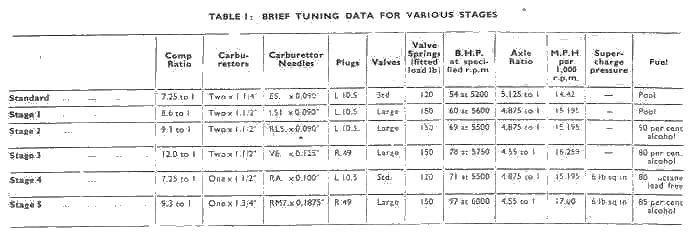
speed on top gear.
The car is quite happy in city traffic generally, yet it should be recorded
that on one occasion only, in very dense slow-moving traffic, it did show signs
of getting hot. On all other occasions, including fast main road and hilly
journeys, as well as during the actual performance testing, no trouble of this
kind was experienced. With the extra set of spring dampers fitted the car has a
much firmer ride at high speeds at the cost of some increased vibration over
rough surfaces at low speed. For Stage 2 the compression ratio is further
increased to 9.3 to I by machining a total of 0.125 in off the cylinder head,
which is the absolute maximum that can safely be removed. As in Stage 1, large
valves are used, and the twin 112-in bore S.U. carburettors were tuned to suit,
the 50 per cent alcohol fuel. At this stage the engine develops 69 bh.p. at
5,500 r.p.m. as compared with 54 b.h.p. at 5,200 r.p.m. when in standard form,
or 60 bh.p. at 5,600 r.p.m. with the Stage I tuning. Compared with Stage 1,
perhaps the most notice- able thing about the behaviour is the very
considerable in- crease in smoothness, yet the gain in maximum speed is not
nearly as marked for the 9 b.h.p. increase as it is between the standard engine
and -Stage I for an increase of only 6 b.h.p. This is, of course, brought about
by the shape of the
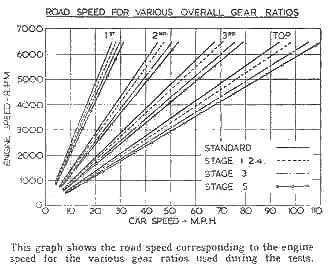
power required curve, and shows the effect of wind resistance
as the speed is increased. The acceleration figures from a standing start
through the gears show an overall improvement; accelerations on one gear from
constant speeds are slightly worse. The fuel consumption is considerably
increased, but this is not surprising, because of its high alcohol content. It
is possible to run in this stage of tune on 80 octane fuel. This would enable
the car to be used for normal running in countries where this type of fuel is
available. Both Stages 3 and 5 of the tuning are in- tended for competition use
only, and will therefore be dealt with together later. Adding a Blower Next,
then, we come to Stage 4, which consists of super- charging the engine in
standard form, but using the 4.875 to I axle ratio (as fitted in Stages I and
2). In this form the engine is blown at 6 lb per sq in by means of a Shorrock
supercharger, which is belt driven from the engine crank- shaft, and for this
stage it is fed by a single 1.5 in S.U. carburettor. For test purposes 80
octane lead-free aviation fuel was used, although it is possible to run on 70
octane fuel, at the expense of a slight reduction in output. In the past there
has been perhaps a feeling that when a car is supercharged it, at once becomes
messy, unreliable, and likely to blow up at the slightest provocation. This may
have been true in the past, when some of the problems connected with
supercharging were not fully understood, but it certainly does not apply to the
Stage 4 M.G. The general improvement in , filling and distribution brought
about by the blower results in an overall improve- |
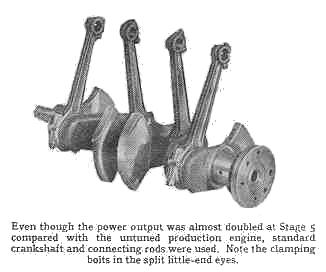
ment in performance as regards both maximum speed and
acceleration compared with Stage 2. On the other hand, the fact that it does
not have such a good bottom end as the standard engine is reflected by the
acceleration figures from a constant 10 and 20 m.p.h. on top gear. It must be
remembered that the change in axle ratio will affect the result slightly.
However, compared with the general improvement in performance this effect is of
little moment, as a driver could overcome it by use of the gears, yet it does
show what is perhaps the major difficulty in tuning; that is, to obtain an
overall increase in power output with-, out losing the bottom end or engine
flexibility. In this supercharged form the car is quite suitable for normal
road use, but the fuel consumption is, of course, increased as compared with
the unblown engine; also, as the oil supply for the supercharger is taken from
the engine, the sump must be replenished more frequently than when the engine
is unblown. The supercharger is quiet in operation. In fact, it is not until
the engine is really starting to rev that the familiar whine is heard at all.
No difficulty in starting from cold was experienced. The stages dealt with so
far cover tuning suitable for a car that is used to some extent as a normal
road vehicle, In the next issue the two remaining stages will be considered
that are intended purely for competition work and not suit- able for normal
use. General impressions and results will also be discussed.
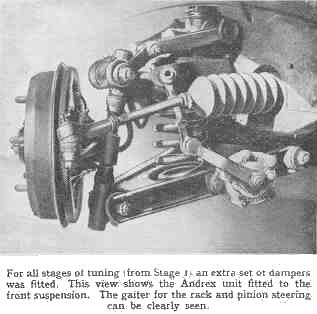 |
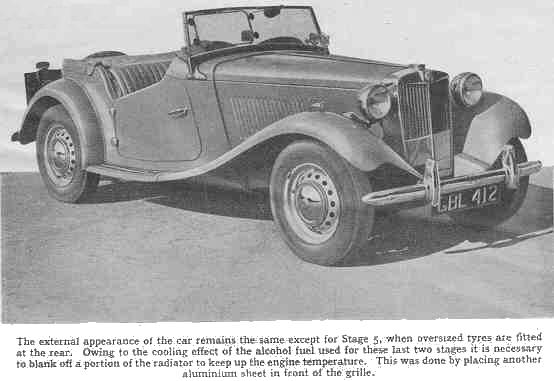
SOME of the general problems connected with tuning have been
considered, together with results obtained with those stages that are suitable
for normal road operation if the correct grade of fuel is available. To
complete the picture there remain two further stages which are really suitable
only for competition work, although during tests the car was driven on the road
in both these conditions for a considerable distance.
At Stage 3 the car has the character and, perhaps, the temperament of a racer.
This is not surprising, as the engine now has a compression ratio of 12 to I
obtained by using a cylinder head of standard dimensions in conjunction with
special pistons. Large diameter valves are, of course, fitted, and the 80 per
cent alcohol fuel is metered by twin I 'I'M S.U. carburettors. At this stage
starting from cold is best performed with the aid of a rope and a tender car,
unless there happens to be a team of strong men available to push. However,
once the engine is warm starting can easily be performed with the standard
starter motor, and in such
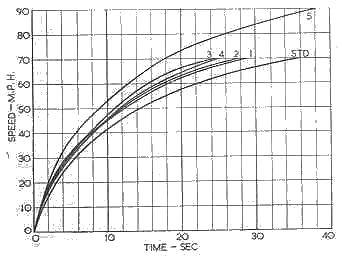 |
circumstances, during
the test, the response was almost instantane'ous. With 78 b.h.p. at 5,750
r.p.m. now available, it is necessary to change the rear axle ratio to 4.55 to
I to make effective use of the new-found top end power without over-revving the
engine. These modifications produce an increase in maximum speed of 3 m.p.h.
compared with Stage 4. They also give a noticeable improvement in the
acceleration times from a standing start through the gears, in spite of the
change in axle ratio. On the other hand, acceleration times on any one gear do
not show any improvement; in' fact, they are, if anything, slightly worse.
The car is very pleasant to drive at this stage provided that the lack of
bottom end flexibility compared with that available with the engine in standard
form is remembered, and the car driven accordingly. It is also very important
to maintain the correct engine temperature, as the cool
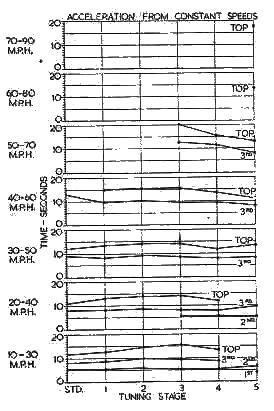 |
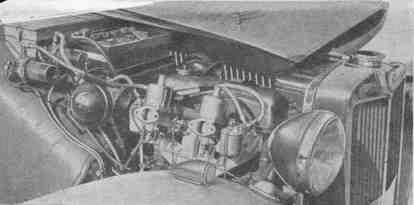 |
For Stage 3 (l2 to 1
compression ratio) large twin S.U. carburettors are used. These are supplied
with fuel by the twin electric fuel pumps mounted on the scuttle, piped so that
both pumps supply both carburettors. This is necessary to prevent possible
starvation of fuel, as the excessive temperature caused by a weak mixture could
produce extreme overheating. |
running qualities of
the alcohol fuel can, in certain circumstances, cause over-cooling, which may
result in lumpy running at low speeds, accompanied by some hesitation when the
throttle is opened. During this test, which was carried out at an air
temperature of 59 deg F, it was found necessary further to blank off the
radiator for the acceleration tests in constant gears, although for other tests
the single aluminium sheet fitted, as shown in one of the photographs, was
entirely satisfactory. Mixture strength is of the utmost importance at this
stage, as any weakness could easily cause overheating, which could have very
serious results. Under normal conditions, this would not happen, but a
temporary starvation could take place if the car were driven with only a very
small quantity of fuel in the tank, and fuel movement during rapid cornering,
for example, permitted air to enter one of the fuel lines. It is therefore
advisable to keep a considerable quantity of fuel in the tank to eliminate this
possibility.
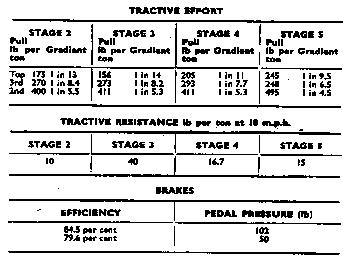
The final test in this group is Stage 5, which consists of the
9.3 to 1 compression ratio engine, supercharged at 6lb per sq in by means of a
Shorrock blower. As in Stage 3, the car is fitted with the 4.55 to I rear axle
ratio, but oversized tyres are used to give 17 m.p.h. per 1,000 r.p.m engine
speed, compared with 16.258 m.p.h. per 1,000 r.p.m for Stage 3 with 5.50-15 in
tyres.. With 97 b.h.p. available under the bonnet, the little T.D. really does
go like a bomb, |
and when driven on
the road it has been responsible for a number -of puzzled expressions on the
faces of drivers in cars that it has passed, and who did not know that the car
was tuned. Considering the type of body, which does not cheat the wind as well
as some, the maximum speed of 96 m.p.h. (approximately I m.p.h. per b.h.p.),
with the hood and side screens in position, is very good. It can be further
increased,' to just over the 100 mark if the car is &ted with a full
tonneau cover and an aero screen. What it would do with a full streamline body
must be left to the imagination, or to Goldie Gardner. Normal racing car drill
must be performed as regards plug changing at Stage 5. Often the engine could
be started from cold by the normal starter motor, although this was difficult
at times and the rowing method had to be used. Starting from hot could easily
be performed at all times with the starter. Because of its potential maximum
speed this Stage 5 test was carried out in Belgium on the Jabbeke motor road.
On the road itself, which is excellently surfaced, the car ran 'very well
indeed. However, on some of the smaller roads leading off the main highway the
pave is very uneven, and on these surfaces some irregularity in running was
noticed, but this stopped again as soon as the car returned
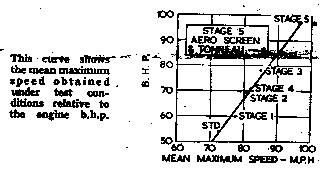
-to a smooth road. This is interesting, and may have been
caused by frothing of the alcohol, the condition being accentuated by the
firmness of the suspension when fitted with the additional dampers. Under
normal conditions the standard clutch was quite satisfactory in dealing with
the much increased power output, yet under the strenuous conditions of the
repeated standing start acceleration tests slip was experienced, but only at
this stage. There are a number of points that arise from an examina-
|
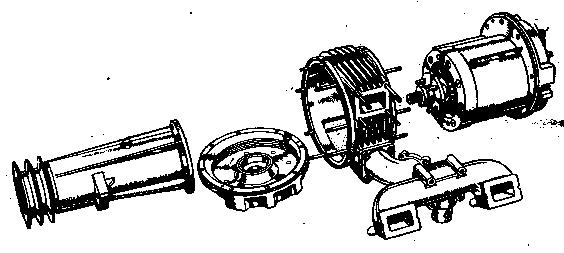 |
An exploded view showing the
mechanism of the eccentric vane type supercharger fitted to the M.G. engine.
The inlet elbow is arranged to suit the three- bolt flange on the large
carburettor used for Stage 5. In the centre of the inlet manifold at the bottom
is the super- charger blow-off valve. Lubrication is provided by oil piped from
the engine to the union that can be seen behind the rear end-plate of the
supercharger. |
| tion of the results
of these tests. First, before any tuning is undertaken at all it must be
decided for what purpose the car is required. There is absolutely no point in
tuning for its own sake with no ultimate aim in view; also an engine should not
be tuned more than is necessary to give the desired result, as this would only
unduly stress the components and also increase the fuel bill. Perhaps one of
the things that is most noticeable is the way that engine flexibility at the
bottom end is lost as the top end power output is increased. This loss, of
course, can be compensated for by modifications in driving methods, which will
result in an overall gain in performance, but again this will mean in- creased
fuel consumption. This is perhaps best illustrated by reference to the graphs
showing acceleration times on any one gear, and from rest through the gears. It
will be seen that as the tuning proceeds it is possible to make the car go
progressively more quickly if the gears are ,used. On the other hand, if the
gears are not used the acceleration time from, say, 10 to 30 m.p.h. on top gear
will get longer as the tuning proceeds, until at stage 5, for ex- ample, the
car tested would not run satisfactorily below a speed of 25 m.p.h. on top gear,
with the result that no figures on this gear at a speed below 30 m.p.h. were
recorded. However, this was the only stage at which acceleration times for
speeds of 70-90 m.p.h. on top gear could be recorded. This again emphasizes the
fact that as the power available at the top end is increased by tuning,
flexibility at low speeds is reduced. In other words, you cannot have it both
ways. of this power being used in overcoming, wind resistance. becomes more and
more noticeable. This is illustrated in the graphs showing the m.p.h. per,
b.h.p.- engine output.. From these it can be seen that for the standard engine
54 b.h.p. gives a mean maximum speed of 72.5 m.p.h. An increase of 17 b.h.p.
(to Stage 4) increases the mean maximum speed by only 9.5 m.p.h. |
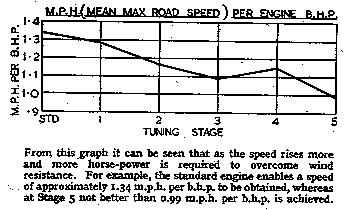
Again, at Stage 5 the engine develops 97 b.h.p., which
represents an increase of 43 over the standard engine; this 43 b.h.p. results
in an increase in maximum road speed of 23.5 m.p.h. at the top end, most of
this power being used in overcoming wind resistance. That is why for a given
body style the increase from the standard to Stage 1, which results in a gain
of 5 m.p.h. for 5 b.h.p., is not repeated in the same ratio farther up the
range. Stages 2 and 4 give rather similar results, and show two ways of
obtaining somewhat similar outputs. Both the high compression ratio engine in
Stage 2, and the supercharged standard compression ratio engine of Stage 4, can
be driven on the road for normal transport with somewhat similar performance.
What, then, should decide which arrangement of tuning should be used? For road
operation the differences in output are not sufficiently great to be noticed
under normal conditions. In fact, acceleration times through the gears from
0-50 m.p.h. are almost identical. However, above that speed the supercharged
engine is at a slight advantage, though it is rather more thirsty than the
unblown ver- |
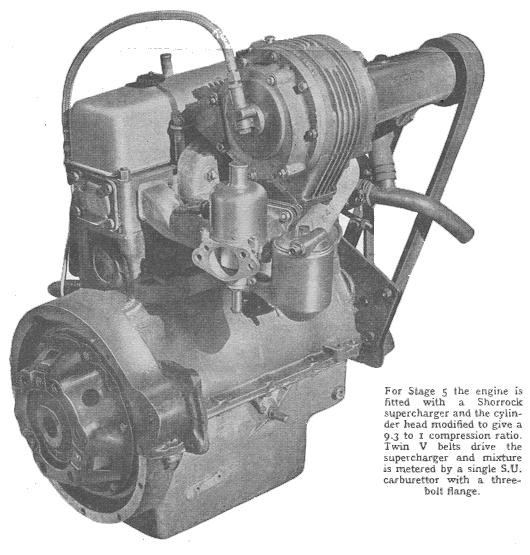
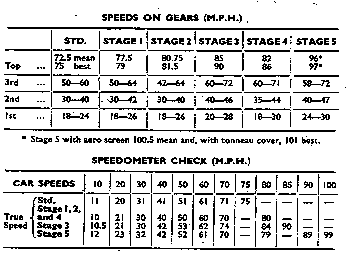
sion. This is interesting, because Stage 2 is using a 50 per
cent alcohol fuel, whereas the supercharged version (Stage 4) runs on 80 octane
lead-free aviation spirit.
For competition purposes handicap arrangements would obviously tend to militate
against the use of a supercharged engine in any other form than Stage 5, as
both Stages 2 and 3 could produce results similar to or better than those from
the supercharged version at Stage 4, without penalization
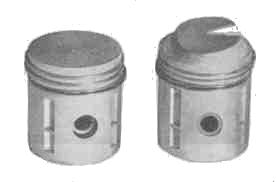 The left-hand piston is of the standard
production type used for Stages, 1, 2, 4 and 5, while on the right is the
special piston used for Stage 3, which, in conjunction with a standard cylinder
head, gives the compression ratio of x2 to 1. The left-hand piston is of the standard
production type used for Stages, 1, 2, 4 and 5, while on the right is the
special piston used for Stage 3, which, in conjunction with a standard cylinder
head, gives the compression ratio of x2 to 1.
from a competition angle. On the other hand, supercharging the
engine according to Stage 4 does enable a very considerable increase in power
output to be obtained with very little actual modification to the power unit,
whereas the other stages require a number of internal modifications. It is
therefore quite simple to convert the standard engine to Stage 4 and back to
standard conditions again without obtaining a new or modified cylinder head, as
would be required for most of the other stages. It must be remembered that
modifications to the axle ratio are necessary to get the maximum output from
the various stages of tuning.
To enable all stages of tuning to be carried out it is necessary to have at
least three cylinder heads and two alternative sets of pistons, as well as
three sizes of carburettor and special valve gear, and with these components
available the |
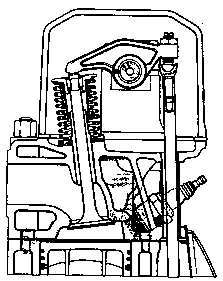
To obtain a compression ratio Of 9.3 to I (as used in Stage 5)
the cylinder head is machined to form a compact combustion chamber. A standard
piston is used.
M.G. can be tuned to suit a very wide number of requirements.
The general design and the construction of the power unit as a whole are
sufficiently robust to enable these large increases in power output to be
obtained without fear of component failure or general lack of reliability. Yet
it must be realized that, as the tuning is increased and the components become
more highly stressed, so will the rate of wear and tendency towards
unreliability be increased. This is only natural and does not reflect in any
way on the design; if fact, it speaks very well indeed of the engine design
when it is realized just how much power can be extracted from it without
modifying the basic components such as the crankshaft or connecting rods, for
example.
Obviously, any owner wishing to tune his car will have his own ideas as to how
far he wishes to go, but, briefly,' from the tests it would seem that Stage I
tuning would suit the requirements of most people who want their Midgets to go
rather faster than average without too much of an increase in the fuel bill.
Stages 3 and 5 shoulid be reserved for competition work only, while Stages 2
and 4 can be used for either road or competition work at the expense of an
increased fuel consumption, and in a car used for road work, only provided that
the correct type of fuel is readily available.
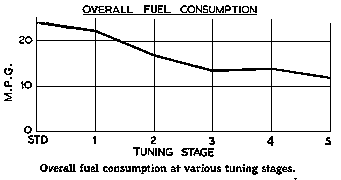 |
 |




